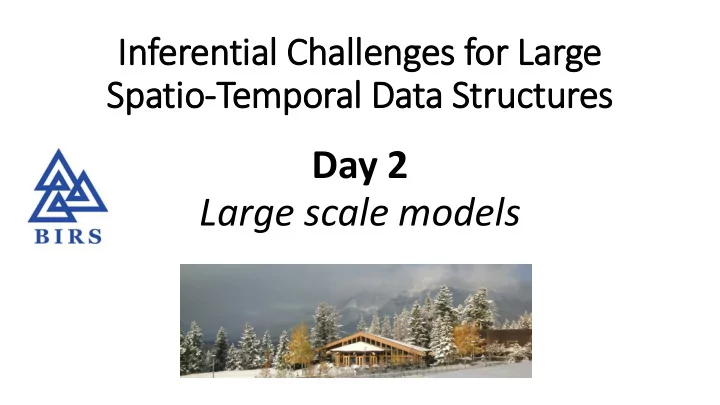

Inferen enti tial Ch Challen enges f for L Large e Spatio-Tem empor oral Da Data S a Structures Day 2 Large scale models
Today’s schedule (morning) • 9:00-9:10 Wit, Insight, and Matters of Great Importance [T. Duchesne] • 9:10-9:55 Regional climate model assessment via spatio-temporal modeling [P. Craigmile] • 9:55-10:05 Discussant [D. Becker] • 10:05-10:15 Floor discussion • 10:15-10:45 Coffee Break • 10:45-11:30 A projection-based approach for spatial generalized linear mixed models [M. Haran] • 11:30-11:40 Discussant [J.-F. Coeurjolly] • 11:40-11:50 Floor discussion • 11:50-12:00 Interesting and important stuff [T. Duchesne] • 12:00- 13.15 Lunch
Today’s schedule (afternoon) • 13:15 -13:35 GROUP PHOTO • 13:35-14:20 Distributed Spatial Kriging: Scalable Bayesian Framework for Massive Spatially Indexed Datasets [R. Guhaniyogi] • 14:20-14:30 Discussant [B. Taylor] • 14:30-14:40 Floor discussion • 14:40-15:15 Coffee break • 15:15-16:00 Challenges in modelling geolocated health data [T. Smith] • 16:00-16:10 Discussants [L. Waller, P. Nguyen] • 16:10-16:30 Floor discussion • 16:30-16:45 Wit, Insight, and Matters of Great Importance [T. Duchesne] • 17:30-19:30 Dinner
What does “large scale” mean? My definition of a large scale situation: When what you usually do and works well stops working well because something has become too large.
Challenges with large scale models The obvious one : computational issues (i.e., data storage, memory, number of floating point operations, etc.) - inversion of large, non-sparse , matrices - numerical integration in high-dimension - interpolating/predicting the value of this process at (potentially a large number of) new locations!
Challenges with large scale models The obvious one : computational issues Examples that we will see today: - Large correlation/covariance matrices that must be inverted - Models with a large number of random effects that must be integrated out - High dimensional posterior distributions computation (or simulation from) - Comparing output of model(s) to observations over large spatial domain
Challenges with large scale models The obvious one : computational issues Example of another type of computational challenge: - Integrating a large number of Doppler radar images over time to improve estimation of cumulative precipitation [would be very useful for forest fire management agencies]
Challenges with large scale models
Challenges with large scale models NEXRAD on AWS The Next Generation Weather Radar (NEXRAD) is a network of 160 high- resolution Doppler radar sites that detects precipitation and atmospheric movement and disseminates data in approximately 5 minute intervals from each site. NEXRAD enables severe storm prediction and is used by researchers and commercial enterprises to study and address the impact of weather across multiple sectors. The real-time feed and full historical archive of original resolution (Level II) NEXRAD data, from June 1991 to present, is now freely available on Amazon S3 for anyone to use . This is the first time the full NEXRAD Level II archive has been accessible to the public on demand. Now anyone can use the data on-demand in the cloud without worrying about storage costs and download time.
Challenges with large scale models The less obvious one : modeling issues - Difficult to obtain a valid joint distribution over all n observations when global model is broken into several smaller pieces - Priors must be specified for a large number of parameters … which translates into several hyperparameters to specify/model - Stationarity, isotropy and other simplifying assumptions tend to hold locally, but not over a large scale
Challenges with large scale models The less obvious one : modeling issues Another example in property insurance: - Can a company come up with a single geographic rating model for a given jurisdiction (e.g., province), which consists of the union of a large number of highly heterogeneous areas (e.g., large cities, small cities, rural areas, cottage country, etc.)?
Challenges with large scale models Another less obvious one : inferential issues - Spatial confounding - Predictors and response measured at different scales or locations, or different predictors measured in different areas - Non-uniform non-detection
Challenges with large scale models Solutions proposed today - Compare distributions of observations and large-scale model output > Use key features of these distributions > Approximations - Reduce the dimensionality of random effects > PCA using random projections - Divide-and-conquer > Don’t break-up space into pieces but use K representative sub-samples - Fit full spatio-temporal latent GP > Use extended grids, fast Fourier transform, additivity assumptions - Address spatial confounding > Modeling > Restrict random effects to be orthogonal to fixed effects
Recommend
More recommend